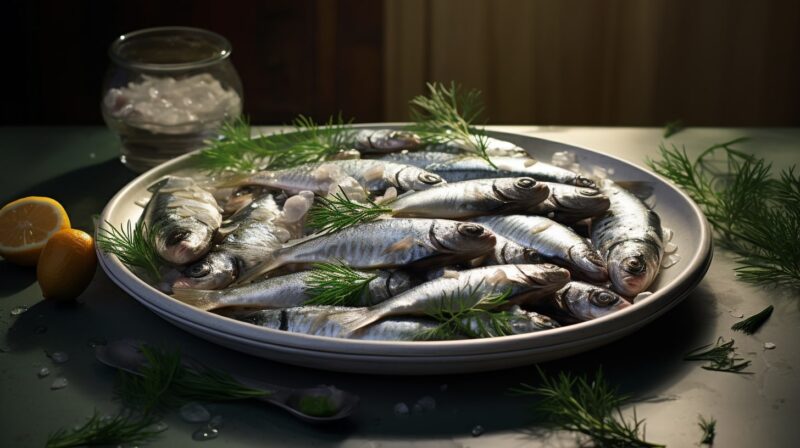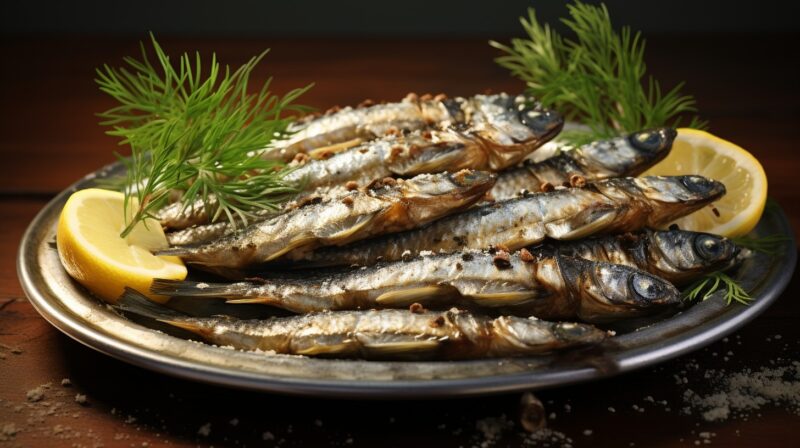
When it comes to seafood, two names often pop up in conversations: herring and sardines. Both have been staples in various cuisines for centuries, and I’ve often found myself in grocery aisles, pondering the subtle distinctions between them.
At first glance, they might seem similar – both are small, oily fish that are praised for their health benefits.
As I go through the comparison, I’ll explore their origins, nutritional profiles, and the unique culinary roles they play in dishes around the world.
Physical Characteristics
Examining fish at the market, distinguishing between various species can sometimes be a challenge. Herring and sardines, although similar in many respects, have unique physical characteristics that set them apart.
Appearance
Herring are generally larger than sardines. They possess a sleek, silvery-blue hue with a distinctive shimmer. Their streamlined bodies have a pronounced dorsal fin and are often characterized by their pointed snouts. On the other hand, sardines are smaller and often display a golden or bronze tint on their bodies.
They too have a streamlined shape, but their snouts tend to be less pronounced than those of the herring.
Size
Herring can grow up to 18 inches in length, though most commonly found specimens are around 12 inches. Their size makes them more meaty, a feature that’s appreciated in various cuisines. Sardines are more petite, usually measuring between 5 to 8 inches in length.
This smaller size contributes to their tenderness and delicate flavor, which many consumers prize.
Taste and Texture

Taste is subjective, but understanding the general flavor profiles and textures of these fish can guide culinary adventures. Herring has a distinct, slightly sweet flavor, which is more pronounced when it’s fresh. Its flesh is soft, making it perfect for dishes where a delicate texture is desired.
Smoked or pickled versions have a more intense taste, often influenced by the accompanying ingredients. I’ve often found that its subtle sweetness pairs wonderfully with acidic or tangy accompaniments. Whether it’s a squeeze of lemon or a dash of vinegar, these additions elevate its flavor.
Sardines, canned or fresh possess a more robust flavor, often described as umami-rich. Their flesh is firmer compared to herring, and they have a distinct oily texture. This oiliness is where much of their nutritional value lies.
For those new to sardines, I’d suggest starting with milder preparations, perhaps grilled with herbs. Over time, as the palate becomes accustomed, one can venture into more intense flavor pairings.
Health Implications
The health benefits of fish consumption are widely recognized. But when comparing these two, are there specific advantages one has over the other? Research suggests that regular consumption of this fish can promote heart health.
The omega-3 fatty acids play a role in reducing bad cholesterol levels, thus potentially lowering heart disease risk. Its high DHA content is beneficial for brain health. It aids in brain development in young ones and can potentially slow cognitive decline in the elderly.
It’s no wonder it’s often labeled as “brain food.” These little fish are bone-strengthening champions, thanks to their calcium and vitamin D content. Regular consumption can aid in maintaining bone density, especially crucial for post-menopausal women.
Their anti-inflammatory properties, courtesy of their omega-3 content, can help combat chronic diseases like arthritis. Their role in mental health, particularly in mood regulation and cognitive function, is also noteworthy.
Nutritional Profile

When considering a healthy diet, the nutritional content of food is paramount. Both of these fish are renowned for their health benefits, but let’s break down their nutritional components to see how they stack up against each other. Herring is a treasure trove of nutrients. But sardines can be low on calories and healthy as much as herring.
It’s lauded for its high omega-3 fatty acid content, which is essential for heart health and reducing inflammation. Additionally, it offers a good dose of vitamin D, vital for bone health and immune system function. But that’s not all.
The protein content in this fish is commendable, making it an excellent choice for muscle repair and growth. And if you’re looking for antioxidants, it doesn’t disappoint with its selenium content, which combats oxidative stress.
What sets them apart is their impressive vitamin B12 content, crucial for nerve function and DNA production. They also serve as a good protein source, and their selenium content is on par with their counterpart, aiding in antioxidant processes.
| Nutrient | Herring (per 100 grams) | Sardines (per 100 grams) |
|---|---|---|
| Omega-3 Fatty Acids | High | High |
| Vitamin D | Good Source | High |
| Vitamin B2 | – | High |
| Vitamin B12 | – | High |
| Potassium | – | High |
| Phosphorous | – | High |
| Protein | 14.2 g | 24.6 g |
| Carbohydrates | 1.6 g | 0 g |
| Calcium | 77 mg | 382 mg |
| Iron | 1.22 mg | 2.92 mg |
| Sodium | 870 mg | – |
| Mercury Levels | – | Exceptionally Low |
Where Do They Come From?
Herring thrive in cold, temperate waters of the North Atlantic and the North Pacific. They tend to prefer coastal waters, but can also be found further out at sea. Schools are known to migrate considerable distances, adapting to seasonal changes.
It is distributed across both the Atlantic and Pacific Oceans, with significant populations off the coasts of Europe, North America, and Asia. Their wide distribution has made them a staple in many global cuisines. Sardines predominantly inhabit warmer waters, especially those of the Mediterranean and the Pacific coast of South America.
They are coastal fish, often found near the shoreline, and are less migratory than herring. Their distribution is somewhat limited but they are still found in abundance in their preferred habitats. Key sardine fishing areas include the Mediterranean, the west coast of South America, and parts of the Indian Ocean.
Conservation Status

With rising global demand, the conservation of marine resources has become paramount. Both herring and sardines have faced challenges, but conservation measures are in place to ensure their sustainability.
Population Dynamics
Historically, herring populations have seen fluctuations due to overfishing. Strict quotas and management practices have been introduced in many regions to ensure the fish’s sustainability and long-term survival. Sardines, on the other hand, have faced dramatic population declines at times, especially off the California coast.
Natural cycles, combined with fishing pressures, have led to these fluctuations. Like herring, measures are in place to monitor and manage sardine stocks.
Conservation Efforts
Conservation organizations and governments alike recognize the importance of sustainable herring and sardine fisheries. Regulations, quotas, and seasonal bans are some of the strategies employed to maintain healthy populations of both species.
FAQs
Can I use herring as a substitute for sardines in recipes (and vice versa)?
Yes, you can often substitute one for the other in recipes due to their similar texture and flavor profiles. The distinct taste of each might slightly alter the dish’s final flavor. You can also use sprats as a sardine substitute.
Why are herring sometimes sold as sardines in stores?
Due to their similarities, herring is sometimes canned and labeled as sardines. It’s essential to read labels or ask vendors to ensure you’re getting the specific fish you want.
Which fish is more sustainable to consume?
Both herring and sardines are considered sustainable choices, but it’s crucial to check for certifications like the Marine Stewardship Council (MSC) label and be aware of sourcing to make the most environmentally-friendly choice.
Do herring and sardines have strong flavors?
Both fish have distinct flavors, often described as “fishy.” Sardines might have a slightly stronger taste compared to herring, which has a milder, buttery flavor.
Are there any allergies or health concerns associated with consuming these fish?
As with any seafood, some individuals might be allergic to herring or sardines. It’s essential to consult with a healthcare professional if you have concerns about allergies or dietary restrictions.
Summary
Having sifted through the nuances of herring and sardines, it becomes evident that each fish has its distinct characteristics. While they share some common ground in terms of health benefits and general uses, their individual flavors, textures, and histories set them apart.
It’s not a matter of ranking one above the other; it’s about appreciating the diversity they bring to our tables. Whether you lean more towards the mild taste of herring or the distinct flavor of sardines, it’s essential to recognize the richness and variety that the marine world offers us.
Related Posts:














